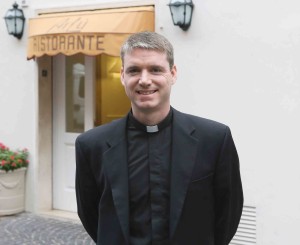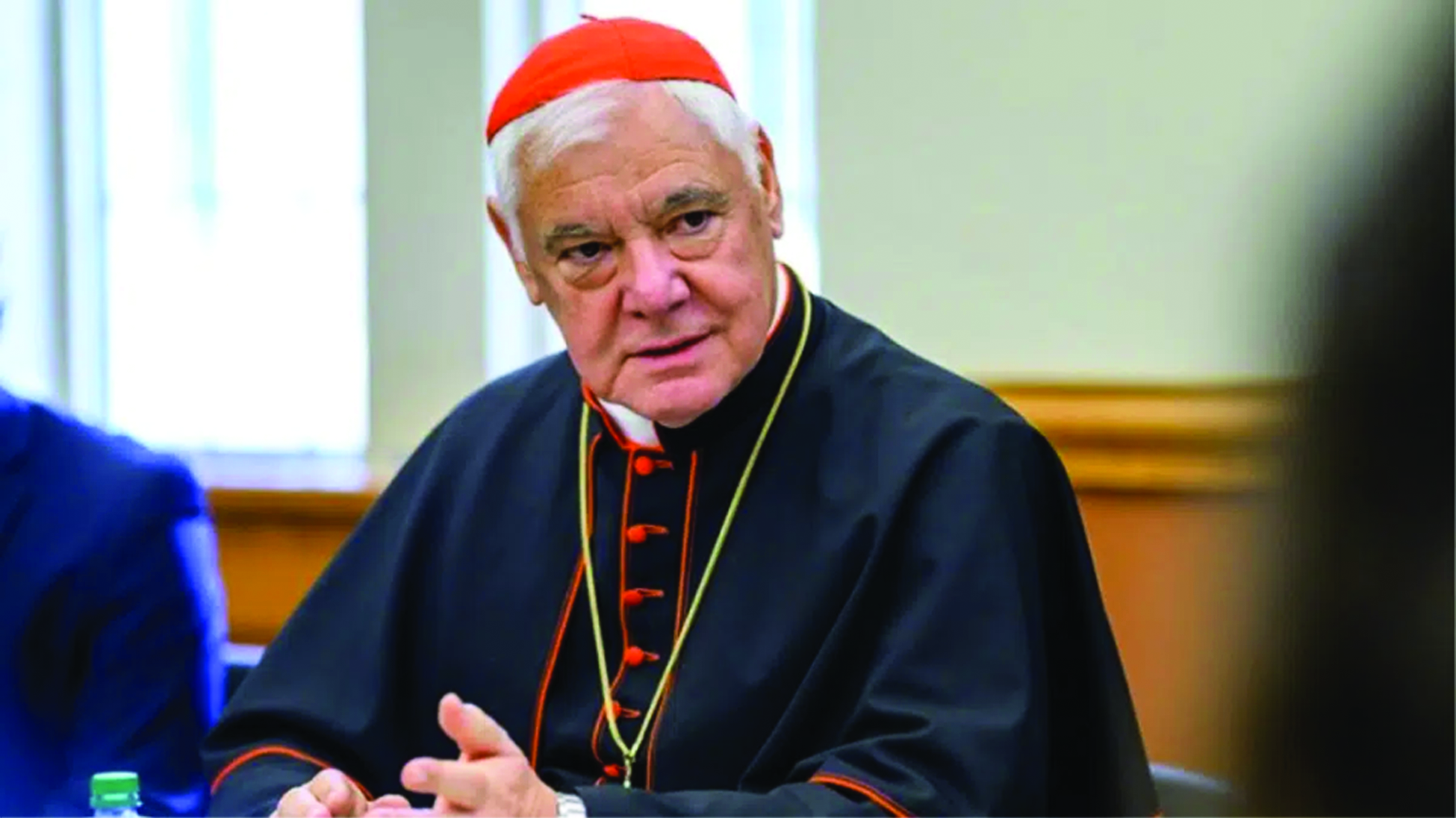The Pope has set up a new Latin academy. A talk with Msgr. Daniel Gallagher, an American Latin expert in the Vatican’s secretariat of state, on the use of Latin in the Vatican.
“Habemus Papam! (“We have a Pope!”) With these two Latin words, the senior Cardinal Deacon of the Catholic Church, speaking from the central balcony of St. Peter’s, tells the world a new Pope has been elected. The formula is: “Annuntio vobis gaudium magnum: Habemus Papam! Eminentissimum ac reverendissimum Dominum, Dominum [First Name] Sanctæ Romanæ Ecclesiæ Cardinalem [Last Name], qui sibi nomen imposuit [Papal Name]. In English: “I announce to you a great joy: We have a Pope! The most eminent and most reverend Lord, Lord [First Name] Cardinal of the Holy Roman Church [Last Name], who takes for himself the name of [Papal Name].”
In announcing the new Pope, the first name is announced in Latin in the accusative case (e.g., for the last few Popes, Angelum Iosephum, Ioannem Baptistam, Albinum, Carolum, Iosephum), but the last name is given in the undeclined form (e.g., Roncalli, Montini, Luciani, Wojtyła, Ratzinger). The new papal name is usually given in the genitive case in Latin, corresponding to the translation “who takes the name of…” (e.g., Ioannis vicesimi tertii for John XXIII, Ioannis Pauli primi for John Paul I).
So, yes, Latin is still used in the Church. In fact, even today, it remains the “official” language of the Church. But its use has been in decline for several generations.
Priests trained in the 1950s and before — like Pope Benedict XVI himself — still today generally have a good command of the Latin language. They can speak, read and write it. But many priests trained since the 1960s are less proficient in the ancient language than in the past. Is this a problem? Some Church leaders think it could be.
They fear the Church could “lose touch” with important parts of her past, that the full comprehension of Catholic teaching in areas as diverse as dogmatic theology, spirituality and canon law could be lessened by an inadequate knowledge of the original Latin, the language in which, for nearly 20 centuries, these disciplines were studied and developed.
And one of the men who fears such a possible consequence is the Pope himself.
Alarmed by the recent decline in the use of Latin within the Church, Pope Benedict this summer made a dramatic decision: to set up an entirely new “Vatican Latin Academy” to try to “breathe new life” into the ancient language.
Cardinal Gianfranco Ravasi, the president of the Vatican’s Pontifical Council for Culture (and a noted Latin scholar in his own right), informed journalists in August of the Pope’s decision to create the new Pontificia Academia Latinitatis (“Pontifical Academy of Latinity”).
The Latin Academy will employ a staff of “eminent academics of various nationalities, whose aim it will be to promote the use and knowledge of the Latin language in both ecclesiastical and civil contexts, including schools,” Ravasi said.

Msgr. Daniel Gallagher, a Vatican Latin expert, outside Arlu’s Restaurant on Borgo Pio (Galazka photos).
In the Vatican, Latin is currently used and promoted by a small team within the secretariat of state. (This team, in addition to preparing the official Latin texts of Church documents — many now drafted first in modern languages — also runs a Latin poetry competition and puts out a Latin magazine.)
Benedict hopes his new “Latin Academy,” partnering with academics worldwide, will “promote the knowledge and speaking of Latin, particularly inside the Church,” Father Ciro Benedettini, vice director of the Vatican press office, said on August 31. The new Academy will replace the currently existing Latinitas Foundation.
How much Latin is still actually used in the Church? Quite a bit. Latin is still the language of papal conclaves, of canon law, of the decrees of Congregations, and of Church councils and synods — as was confirmed by Washington, D.C.’s Cardinal Donald Wuerl during October’s Synod on the New Evangelization: Wuerl presented both his relatio ante disceptationem and relatio post disceptationem in an elegant Latin. And in Rome’s Pontifical Universities, the first language for final exams remains Latin, though modern languages are permitted with the approval of the professor. (More and more, students do ask, and are permitted, to be tested in a modern language.)
The end of the wide use of Latin began in the 1930s. Latin, bit by bit, stopped being the language of lectures in Catholic seminaries and colleges. Still, in certain areas, like canon law, Latin remains critical, as basic legal works, codes and terms are all in Latin.
To learn more about the history, structure and beauty of Latin, we sat down on a cloudy October morning with an American monsignor, Daniel Gallagher, 42, from the diocese of Gaylord, Michigan, one of the Pope’s Latinists. We met at Arlu’s, a charming Roman restaurant in the shadow of the Vatican’s walls on the Borgo Pio (a restaurant said to have been one of Cardinal Ratzinger’s favorites).
Gallagher felt called to the priesthood while studying microbiology at the University of Michigan, intending to study medicine. He is involved in the Paideia Institute in Rome which promotes summer programs to study Latin in the Eternal City. His passion for Latin was rooted in a desire to understand better the great Christian authors, like St. Augustine.
In the fourth and fifth centuries, certain public duties began to fall to the Church amid the general collapse of the Roman Empire. As the Church’s administrative and legal role increased, the Pope needed several Latin secretaries. They were the forerunners of the present Secretaria Brevium ad Principes et Epistolarum Latinarum (Secretariat of Briefs to Princes and Latin Letters).
In the past two centuries, the role of the papacy has also grown due to the number of Catholics around the world and the increase in the number of nations with which the Church maintains diplomatic relations. Today, as part of the First Section of the Secretariat of State on the terza loggia (third story), there is a Latin section called the Officium Secretariae Status pro documentis Latina lingua exarandis (“Office of the Secretariat of State for Composing Latin Letters”). There are seven Latin secretaries representing different cultural backgrounds (American, Polish, Spanish and Italian). They are responsible for producing Latin documents for the Pope.
A unique and precious source for the history of Curial Latin remains Cletus Pavanetto’s book Elementa Linguae et Grammaticae Latinae. The modern history of Curial Latin has been shaped by great Latinists, like Antonio Bacci, Carolus Egger, O.S.B., and Antonio Salvi, O.F.M. Cap.
Monsignor, do you test the Latin ability of new Roman Curia employees?
Monsignor Daniel Gallagher: We do not. In the Congregations, a certain level of Latin ability is presumed. The officials must know at least how to read Latin and how to make a simple translation. But generally, nobody tests. The ideal would be, if everybody would be able to write with facility in Latin, as once was the case. Now, each Congregation has at least one person responsible for producing things in Latin and answering letters received in Latin. It is a common misunderstanding that my office is responsible for the Latin of the entire Curia; this is not so. We are only responsible for the Latin directly connected with the Holy Father’s work.

Msgr. Daniel Gallagher with a coffee (Galazka photos)
What kinds of documents do you produce at your office?
Gallagher: Our task is to help the Holy Father with a large number of documents. All the letters connected to official diplomatic activities are in Latin. Often the letters are fairly simple, such as letters of credence for the nuncios to respective countries. There are many letters that appear only in Latin and in no other language, documents that few people see, because of their juridical nature, like the appointment of a bishop or the establishment of a diocese. They are fairly short and there is no reason to put them into English. Most are composed in Latin from scratch; some involve a translation. I think the best word to describe our activity is “secretary,” which is reflected in the term “secretariat of state,” as any secretary is simply helping the Pope to compose in all languages the types of texts he needs to put together. In this sense, Latin is among other languages — French, English, Portuguese — but has a special place because of the weight of Latin as the language of the Church.
Is it true that the first homily a new Pope gives is entirely in Latin?
Gallagher: That is correct. The Pope traditionally gives a homily at the Mass of celebration with the cardinals after the election, and that homily is in Latin. It’s a very important one, because it sets the tone for his papacy, and therefore there is a certain type of nobility to the Latin he uses. There the Latin can be very beautiful, as John XXIII’s speech given at the inauguration of Vatican II, “Gaudet Mater Ecclesiae,” which is fabulous and wonderful in Latin. The kind of language he spoke there is so fresh and shows the best of Latin today.
Is Pope Benedict fluent in Latin?
Gallagher: Absolutely. I remember a story told by a member of the International Theological Commission. The then-Cardinal Ratzinger, at the end of a plenary session, gave a five-minute summary in Latin of the work of four different language groups based on just a few notes. Nobody had been speaking in Latin, so he was clearly able to think in Latin. And in perfect Latin. I once had the opportunity to speak with him in Latin and he didn’t have any difficulty responding in Latin. It’s very impressive. He is a very intelligent man.
Do you speak Latin in your section?
Gallagher: Yes. As much as possible. There are times when we switch to Italian, because that has become the shared language of the Curia. But, we spend a good part of the day speaking Latin. We do it because we enjoy it and also to keep it living, to keep it fresh. We try to write in the clearest and most elegant Latin possible.
Is the stilus Curiae Romanae, the Roman Curial style, still present in your texts?
Gallagher: This style grew very gradually from the end of the 300s to the beginning of the 400s, especially under Popes Damasus (366-384 A.D.) and Leo the Great (440-461 A.D.), and it employed elements of classical Latin via Roman juridical Latin. It differs a little bit from the Latin used liturgically and functionally to spread the Christian message through evangelization. This “Curial” Latin is marked by several things: a rich vocabulary, a real beauty of syntax, and also a kind of melody, a cursus, a combination of syllables at the ends of phrases. We try to imitate this, so the Curial Latin today can be marked by the same characteristics. To be honest, it’s quite beautiful.
Your office is famous for creating new words when necessary…
Gallagher: There are two ways of creating new words. One is to use a classical phrase to describe the modern object, or — and this is a new approach — one can “coin” a new word to describe the new object. So, we would use something like telephonum for “telephone,” which is close enough, instead of the phrase “instrumentum ad loquendum aliis” (“instrument for speaking with others”). That’s an example of the general principle we use. Telephonum makes it simpler. Every language does this to enrich its vocabulary. The “bible” of modern Latin is the Lexicon recentis Latinitatis, an Italian-Latin dictionary with new words given both as descriptive phrases and as single new words. We do create new Latin words, and many people appreciate that because few do it. This is something we do not only for the Church, but also for the world.
You also write the inscriptions for renovations on monuments throughout Rome…
Gallagher: This is not my specialty. I admire my colleagues who do this. It may seem easy, but to choose the right six words sometimes takes weeks or months, to make sure you are using something clear yet concise. Walking around Rome, you can study the history of the entire city just by reading these simple inscriptions on the buildings and fountains.






Facebook Comments